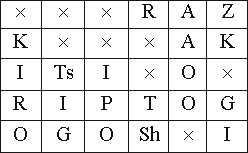Composite matrix cipher based on perfect binary arrays
DOI:
https://doi.org/10.3103/S0735272713030047Abstract
A composite matrix cipher consisting of four partial ciphers and based on perfect binary arrays has been proposed. This cipher possesses an easily controlled level of data protection from unauthorized access and other practically acceptable computational properties.
References
- MAZURKOV, M.I. Broadband Radio Communications Systems: Textbook for Higher Education Institutions. Odessa: Nauka i Tekhnika, 2010. 340 p. [in Russian].
- MAZURKOV, M.I. Class of minimax error-corecting codes based on perfect binary arrays. Radioelectron. Commun. Syst., v.54, n.9, p.481-498, 2011. doi:10.3103/S0735272711090032.
- MAZURKOV, M.I. AND CHECHEL’NITSKII, V.YA. The classes of equivalent and generative perfect binary arrays for CDMA-technologies. Radioelectron. Commun. Syst., v.46, n.5, p.49-57, 2003.
- MAZURKOV, M.I.; CHECHEL’NITSKII, V.YA.; GERASIMENKO, M.YU. Classes of minimax bi-phase signals based on perfect binary arrays. Radioelectron. Commun. Syst., v.49, n.10, p.19-30, 2006.
- JEDWAB, J. AND MITCHELL, C. Constructing new perfect binary arrays. Electron. Lett., v.24, n.11, p.650-652, 1988. doi:http://dx.doi.org/10.1049/el:19880440">10.1049/el:19880440.
- WILD, P. Infinite families of perfect binary arrays. Electron. Lett., v.24, n.14, p.845-847, 1988. doi:http://dx.doi.org/10.1049/el:19880575">10.1049/el:19880575.
- KOPILOVICH, L.E. On perfect binary arrays. Electron. Lett., v.24, n.9, p.566-567, 1988. doi:http://dx.doi.org/10.1049/el:19880385">10.1049/el:19880385
- GEPKO, I.A. Synthesis of perfect binary arrays. Radioelectron. Commun. Syst., v.41, n.6, p.9-16, 1998.
- GEPKO, I.A. Perfect time-frequency codes for multifrequency CDMA technologies. Radioelectron. Commun. Syst., v.43, n.2, p.57-62, 2000.
- CHECHEL’NITSKII, V.Ya. A method for generation of the full class of perfect binary arrays of the order N = 8×8. Radioelectron. Commun. Syst., v.48, n.11, p.58-64, 2005.
- MAZURKOV, M.I. AND CHECHEL’NITSKII, V.YA. The properties of the full class of perfect binary arrays for 36 elements. Radioelectron. Commun. Syst., v.47, n.6, p.48-55, 2004.
- MAZURKOV, M.I. AND GERASIMENKO, M.YU. Fast orthogonal transforms based on perfect binary arrays. Radioelectron. Commun. Syst., v.49, n.9, p.47-52, 2006.
- BARANOV, P.E.; MAZURKOV, M.I.; CHECHELNYTSKYI, V.YA.; YAKOVENKO, A.A. Family of two-dimensional correcting codes on a basis of perfect binary array. Radioelectron. Commun. Syst., v.52, n.9, p.501-506, 2009. doi:10.3103/S0735272709090088.
- MAZURKOV, M.I.; CHECHEL’NITSKII, V.YA.; MURR, P. Information security method based on perfect binary arrays. Radioelectron. Commun. Syst., v.51, n.11, p.612-614, 2008. doi:http://dx.doi.org/10.3103/S0735272708110095">10.3103/S0735272708110095.
- D’YAKONOV, V.P. Mathematica 5/15/2/6/. Programming and mathematical calculations. Moscow: DMK Press, 2008. 576 p. [in Russian].
- SHANNON, C. A mathematical theory of communication. Bell Sys. Tech. J., v.27, n.3, p.379, n.4, p.623, 1948.
- SKLAR, B. Digital Communications: Fundamentals and Applications. 2nd ed. New Jersey: Prentice-Hall, 2001. 1104 p.
- MACWILLIAMS, F.J. AND SLOANE, N.J.A. The Theory of Error-Correcting Codes. North-Holland, 1978. 744 p.

Downloads
Published
2013-03-01
Issue
Section
Research Articles

